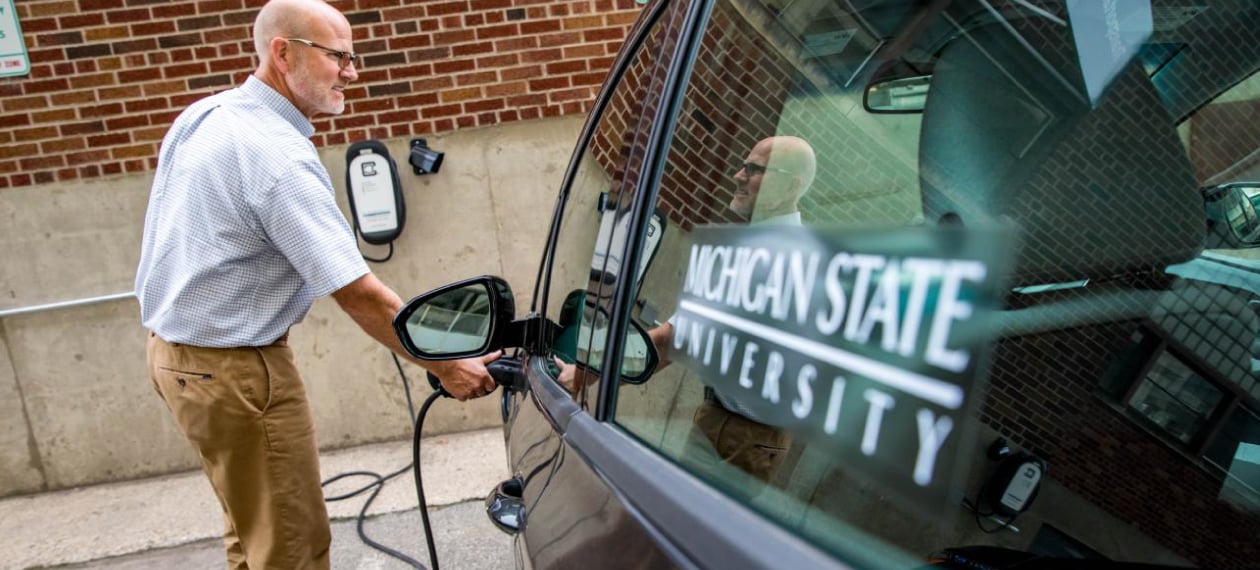Over the next decade, Michigan State University plans to transition one-third of its transportation fleet to zero-emission electric vehicles (EVs), a move that aligns with its goal of climate neutrality by 2050.
As technology improves and prices drop, MSU will convert additional vehicles in its 1,110-vehicle fleet to reduce greenhouse gas emissions by 50 percent – almost 300,000 metric tons of CO2 – from its 2010 baseline.
While that may sound like a pie-in-the-sky target, Director of Campus Services Adam Lawver believes the shift to an all-electric fleet is achievable through the right partnerships and procurement of state and federal funds.
Importance of Partnerships
How can you leverage public-private partnerships?
That was the question MSU pondered when it began strategizing how to transition its fleet, and one that Lawver explored with the audience at the Higher Ed Facilities Forum.
"If you understand state and federal dynamics and available programs, you can leverage subsidies and grants to make your project affordable."
“Partnerships are critical,” he said. “You need to know what’s happening nationally, in your state, and at your university. If you understand state and federal dynamics and available programs, you can leverage subsidies and grants to make your project affordable.”
The Bipartisan Infrastructure Law, Inflation Reduction Act, and the CHIPS and Science Act have all made money available to subsidize electric vehicle purchases, charging stations, and the infrastructure to support them. Universities within one mile of a highway can apply for funds from the National Electric Highway Coalition, whose goal is to locate charging stations across the national highway system.
“In Michigan we have the Charge Up program through the Michigan Department of Environment, Great Lakes, and Energy (EGLE),” Lawver said. “We were able to leverage grants from that program, an overall partnership to help us navigate these different strategies.” MSU also tapped into resources at Consumers Energy, a public utility, for charging stations and installation.
“If you don’t have a current relationship with a utility provider, make a phone call when you get back to your campus. Most likely, they are working with your state to get federal funding and can shepherd you through that process within your campus.”
Investing in a Greener Future
To determine the feasibility of going all electric, MSU hired consultants from ICF International to evaluate the inputs of its existing fleet and compare overall total cost of ownership for internal combustion engine (ICE) vehicles versus EVs.
They considered overall vehicle performance, fuel and maintenance costs, installation, battery performance and battery life, and other charging infrastructure costs to determine the capital cost difference. Contemplating EV replacements in the future, they asked, “What will consumers pay for a used electric vehicle that has 80 percent remaining battery life?”
In 2022, MSU purchased 40 EVs – a mix of sedans, light-duty pickup trucks, and minivans – for just under $2 million. This pilot program will allow the university to analyze vehicle and charger performance along with data generated from converting the 40 ICE vehicles to help inform MSU’s future electric vehicle strategy.
Specifically, it will look at:
- Electricity demands using electrical load management software
- EV performance, especially battery life, to determine total cost of ownership based on data gathered to inform purchasing additional EVs
- The greenhouse emissions impact
- EV supply chain resiliency
Taking an Evidence-Based Approach
“Know your numbers on what your current utilization is, then make good, smart financial decisions on your charging stations, whether DC Fast Charging stations or Level 2,” Lawver advised.
"We're looking at a five-year break-even point for the fast chargers, based on a few assumptions."
Currently, MSU has 14 Level 2 chargers on its ChargePoint platform on campus, requiring eight to ten hours for a full charge. The university also invested in two DC fast chargers for public use, with a charge time of 20 minutes, with funding from Consumers Energy, Charge Up Michigan, and the Capital Area Transportation Authority.
“I’m looking at a five-year break-even point for the fast chargers, based on a few assumptions,” Lawver said, like trying to predict how many people will buy an EV in the next five years, how many of those will use one of MSU’s two charging stations, how much time they’ll spend charging their vehicles, and how much energy they’ll use to do so.
One of MSU’s ultimate goals is to install charging stations on university-owned land across Michigan, including rural areas, not only for university business travel but for public use to encourage an overall shift from ICE vehicles to EVs.
“We’re going to try to develop a cost model, so we can repay the initial investment on these chargers and put money aside for their replacement long-term. So if you have a similar situation, or are part of a coalition within your state to leverage these opportunities, take a look at your land from a real estate perspective and how you might tap into that market.”
Lawver concluded by noting, “There are a lot of things to consider at a university to move toward your greenhouse gas reduction goals. Fleet is just one category to work toward sustainability. So leverage what you are good at, build relationships, and hang on because it’s going to be a really exciting ride.”
Posted by
Join us at HEFF!
An interactive retreat for facilities leaders at the nation's top colleges and universities.
Nov 8-10, 2026 | San Antonio, TX
Learn More









Comments